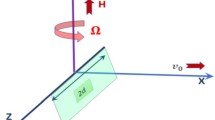Abstract
Conductive transport through an infinite homogeneous medium across a layer of finite thickness, a planar array of infinite cylinders, or a planar array of three-dimensional particles with arbitrary conductivity is considered as a model of mixed-matrix membrane separation. The boundary distribution of the transported scalar field on the interior side of the layer, cylinders, or particles is proportional to that on the exterior side according to a linear sorption/desorption kinetics law, while the conductive flux is continuous across the interface. In the case of cylinders and particles, the solution of Laplace’s equation for the transported field is represented by an interfacial distribution of point sources expressed in terms of the periodic Green’s function of Laplace’s equation in two dimensions or the doubly periodic Green’s function of Laplace’s equation in three dimensions. Analytical solutions for small circular cylinders and small spherical particles are derived based on the integral representation, and numerical solution of integral equations arising from the interfacial conditions are computed by boundary-element methods. The results document the displacement of the linear profile of the transported field far from the interfacial layer or array with respect to that prevailing in the absence of membrane. Expressions for the effective diffusivity of the mixed-matrix membrane are derived.










Similar content being viewed by others
References
Maxwell JC (1904) Colours in metal glasses and in metallic films. Philos Trans R Soc Lond 203:385–420
Cussler EL (1990) Membranes containing selective flakes. J Membr Sci 52:275–288
Mahajan R, Koros WJ (2002) Mixed matrix membrane materials with glassy polymers. Part 1. Polym Eng Sci 42:1420–1431
Noble RD (2011) Perspectives on mixed matrix membranes. J Membr Sci 378:393–397
Petropoulos JH (1985) A comparative study of approaches applied to the permeability of binary composite polymeric materials. J Polym Sci 23:1309–1324
Moore TT, Koros WJ (2005) Non-ideal effects in organicinorganic materials for gas separa-tion membranes. J Mol Struct 739:87–98
Xue L, Borodin O, Smith GD (2006) Modeling of enhanced penetrant diffusion in nanoparticle-polymer composite membranes. J Membr Sci 286:293–300
Singh T, Kang D-Y, Nair S (2013) Rigorous calculations of permeation in mixed-matrix membranes: evaluation of interfacial equilibrium effects and permeability-based models. J Membr Sci 448:160–169
Pozrikidis C (2002) A practical guide to boundary element methods. Chapman & Hall/CRC, Boca Raton
Hautman J, Klein ML (1992) An Ewald summation method for planar surfaces and interfaces. Mol Phys 75:379–395
Maxwell JC (1873) Electricity and magnetism. Clarendon Press, Oxford
Jeffrey DJ (1973) Conduction through a random suspension of spheres. Proc R Soc Lond A 335:355–367
Author information
Authors and Affiliations
Corresponding author
Rights and permissions
About this article
Cite this article
Pozrikidis, C., Ford, D.M. Conductive transport through a mixed-matrix membrane. J Eng Math 105, 189–202 (2017). https://doi.org/10.1007/s10665-016-9889-z
Received:
Accepted:
Published:
Issue Date:
DOI: https://doi.org/10.1007/s10665-016-9889-z




